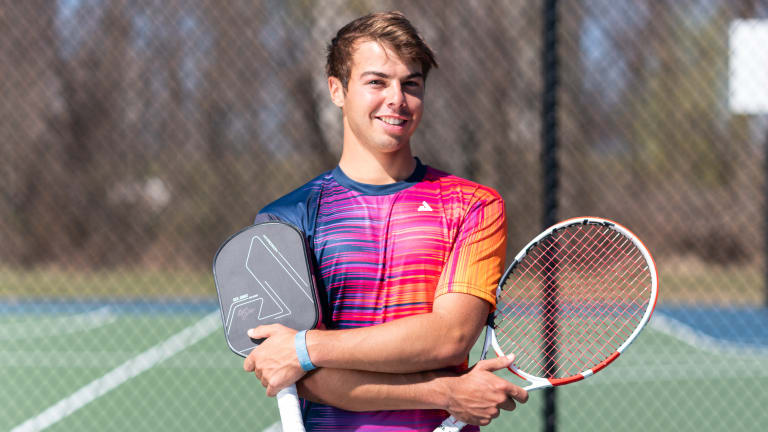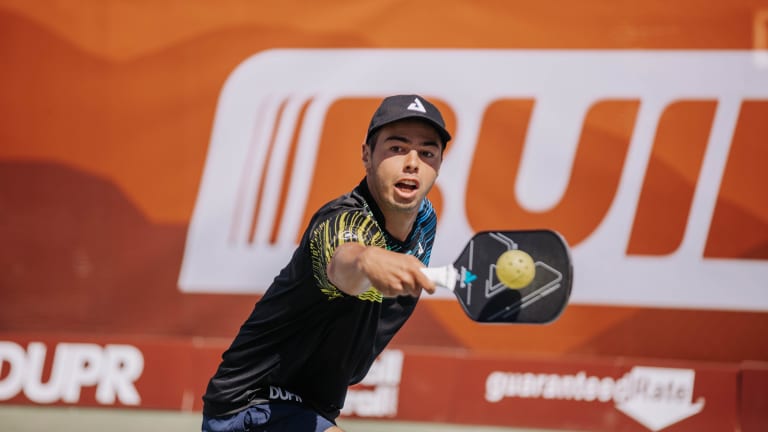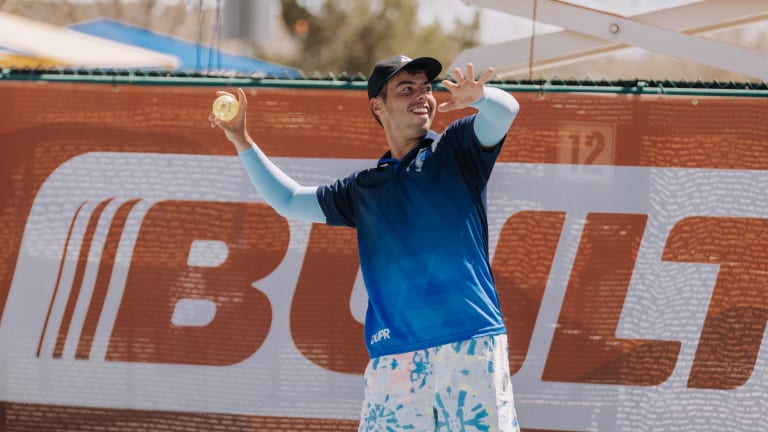Major League Pickleball will be the first major American professional sports league to implement a promotion and relegation system. The draft for the first season—featuring some of the world's best pickleball players and most famous celebrities—will take place in Las Vegas tonight, Thursday, December 15th, and air on Tennis Channel at 9:00 p.m. EST.
pickleball
GOAT @ 23: Ben Johns is a pickleball master with a 'Frankenstein' game
By Dave Fleming Dec 15, 2022pickleball
Jack Sock to play Donald Young in San Clemente pickleball match
By Liya Davidov Jun 18, 2025pickleball
New pickleball series ‘How I Met My Partner’ recognized at Denver Film Festival
By Liya Davidov May 09, 2025pickleball
Andre Agassi wins pro debut match with Anna Leigh Waters at US Open Pickleball Championships
By Liya Davidov Apr 30, 2025pickleball
Andre Agassi to make pro pickleball debut with Anna Leigh Waters at US Open Pickleball Championships
By Liya Davidov Apr 24, 2025pickleball
Andre Agassi will play at US Open Pickleball Championships
By Associated Press Apr 22, 2025pickleball
Genie Bouchard, Donald Young, Jack Sock, Sam Querrey headline doubles at PPA Veolia North Carolina Open
By Liya Davidov Apr 04, 2025pickleball
Jack Sock earns first-career silver medal at PPA Red Rock Open
By Liya Davidov Mar 31, 2025pickleball
PPA Red Rock Open claims Sam Querrey, Jack Sock and Eugenie Bouchard in opening round of doubles
By Liya Davidov Mar 29, 2025pickleball
Jack Sock, Eugenie Bouchard lose in mixed doubles at PPA Red Rock Open ... but are not out of the tournament
By Liya Davidov Mar 28, 2025GOAT @ 23: Ben Johns is a pickleball master with a 'Frankenstein' game
Ben Johns is just getting started, but he’s already the most impressive player that pickleball has ever known. One reason? Tennis.
Published Dec 15, 2022

© PPA Tour
Advertising
Before Ben Johns became a pickleball legend in his 20s, he was a tennis player, both on the court and on the table.
Both sports have played a role in developing Johns’ world-class pickleball game—one that has brought him nine triple crowns (winning singles, men’s doubles, and mixed doubles all at the same tournament), and multiple titles at the USA Pickleball National Championships. But credit must also go to a bookshelf.
“Growing up, I had a bookcase on the left side of the table in our basement,” Johns said recently in an interview, “and usually in table tennis you run around your backhand and hit your forehand loop. I couldn’t, because of the shelf. So I ended up hitting a lot of backhands from every part of the court, which has helped me in pickleball.”
Watching grainy videos of Johns refining his ping-pong strokes in his basement, and while speaking to him today, it’s clear that pickleball has always been a family affair for the Maryland native. Ben plays pro men’s doubles with his older brother Collin, and PPA Tour sideline reporter Hannah Johns—his sister—often gets the pleasure of interviewing her brothers when they win a hard-fought match.
“Sometimes you can’t get around the ball unless you hit it backwards,” Ben remarked to Hannah recently in Austin, Texas, when asked about the art of the pickleball tweener. “As for you amateurs, be careful—that’s all I have to say. Especially for the guys.”
Advertising
In this exclusive interview with PPA Tour lead commentator Dave Fleming, Johns shares how tennis has helped shape his pickleball foundation. He also shares his insights on how tennis players can bring their skills to the pickleball court, and he provides some drills that will help all players—but especially those with tennis backgrounds—improve their games.
What has enabled you to ascend to the top of the pickleball world so quickly?
I credit that mostly to my tennis and table tennis backgrounds. Pickleball is kind of in-between those sports. Having a tennis background obviously helps a lot. The addition of table tennis just gave me something a little extra, that I could adapt for a couple shots. I’m a fairly visual learner, and ‘Frankensteined’ a lot of my game together by borrowing elements from other players and sports.
What is it about the game that interests you?
Pickleball is an unsolved sport. Everyone is adding new shots and strategies all the time— meaning that nobody really knows the “correct” things to do. I think everyone is still learning and adapting to other players. It’s a whole mental game where one player will do something, and everyone has to react to that player—and that’s what makes it a lot of fun, because you’re having to figure it out as you go along.
Most players have a couple things they do really well, but other parts of their games even those things out. If you can take the best things away from other players and try to mimic them, or just learn something from what they do really well, then you can add new things to your game very quickly. That’s how I always learned any sport, including pickleball.
Pickleball is an unsolved sport. Everyone is adding new shots and strategies all the time… That’s what makes it a lot of fun. Ben Johns
Advertising
How did you get started in pickleball, and what role did tennis play in that beginning?
I was a tennis player growing up from age seven. My brother Collin is six years older and was playing tennis professionally, and whenever he wasn’t traveling, I’d be his hitting partner. I was hitting at some local courts where we lived in South Florida and saw pickleball being played and thought, that looks kind of fun. So I gave it a try, and I liked it so much. But it’s not like I saw a future with it or anything at the time.
When did it become more than that, and what was the catalyst?
When I started playing a ton of pickleball in 2016, it so happened that the first US Open was taking place just 30 minutes from where I lived in Estero, Fla. Some friends encouraged me to play, and I learned that it was an open tournament—you sign up for whatever events you wanted to play. And I thought I was pretty good enough where I felt like I could do it.
I played singles and did pretty well, and by that time I was hooked on pickleball, so I kept at it. Soon I was traveling to tournaments, and over the next few years it went from a fun sport to one where you could make a little bit of money. Then major sponsors and more money started coming in, and it became even more serious—where you can now make an excellent living at it.

Already a prolific champion in singles, doubles and mixed, Ben Johns is redefining success in pro pickleball.
© PPA Tour
Advertising
What would you tell a tennis player who wants to get started in pickleball?
First, I’d say that pickleball’s main attraction to everyone, not just tennis players, is that it’s very easy to pick up and have fun on the first day. Tennis players are obviously very coordinated with volleys and ground strokes; pickleball strokes are similar, so tennis players will get off to a good start.
What they’re going to find is that after that good start, they have to make a mental effort to transition from one sport to the other, because you can’t just try to play tennis on a pickleball court. That will get you to a certain point, but not really far, unless you take some things away from your traditional tennis game plan and adapt them to pickleball.
You alluded to this, but what’s the biggest challenge for a tennis player coming over to pickleball?
Tennis is very much a groundstroke game these days. You’re basically just hitting big groundies from the baseline, and a big serve. The main thing in pickleball is knowing when to hit big groundstrokes versus when not to, because a lot of tennis players will just choose to keep whacking away. It becomes clear early on that won’t cut it against decent pickleball players.
Generally speaking, you can pin down success in pickleball to shot selection. That’s definitely the hardest thing for tennis players to learn. But when they get that, it becomes very fun, because they know they have control over the ball. It gets them over that mental hurdle of doing the right thing at the right time, and the sport becomes a lot easier for them.
Tennis players are used to strings making contact with the ball, while pickleball uses a solid paddle. How do you generate spin with no strings?
The paddle doesn’t catch the ball nearly as much, so you’ll see a lot of tennis players trying to use semi-western forehands or even more severe grips, which sends the ball straight into the ground. The best way to think about it as a tennis player is to play a very flat game, like an old-school style of tennis. Volleys are different as well as groundstrokes. In tennis you often cut the ball, or hit it kind of like a slice. Everyone knows the classic tennis volley where the racquet face is open, whereas in pickleball, it’s pretty satisfying that you can do a little more with the ball. There’s not just one way to play.

The 23-year-old recently signed a sponsorship contract with Joola that includes a signature paddle.
© PPA Tour
Advertising
But you can still generate spin, depending on your approach.
The easiest way to generate spin is off volleys. You can roll the ball out of the air with top spin.
I think something a lot of tennis players find very enjoyable is hitting basic volleys. But in pickleball, there are so many different types of volleys that they can have fun figuring out what those are. Think of an old-schooler like Patrick Rafter. He would have a topspin volley sometimes, which is the norm in pickleball. You have top spin volleys and lots of other types.
For tennis players coming over to pickleball who want to work on their game, what are a couple of drills you would recommend?
Every tennis player gets very confused as to what to do in the midcourt, because in tennis you’re not supposed to be there. You’re either up or you’re back, and there’s no in-between. In pickleball you’re going to find yourself there a lot, and if you choose to hit a groundstroke off your shoelaces, it’s not going to go very well.
The first thing you want to learn is what a half-volley reset is, especially in the midcourt. Stand in the midcourt, with your drilling partner at the opposite kitchen line, and have them hit the ball at your feet. Instead of driving that ball off your shoelaces, what you want to do is hit a high half-volley that lands in the kitchen. That’s a favorite drill of mine that I still do, and it’s really important for tennis players because it’s actually an easy shot for them to hit in terms of timing. Getting comfortable with that will go a long way.
I’m a fairly visual learner, and ‘Frankensteined’ a lot of my game together by borrowing elements from other players and sports. Ben Johns
Advertising
What’s one more drill?
Your bread and butter in pickleball—and this is something tennis players will find easier than the midcourt half-volley—is just crosscourt dinking. Once you get to the kitchen line, that’s what you’ve got to get really good at. It’s not that hard to learn, but you’ll want to get your reps in and become good at it immediately, because at some point that’s going to be the shot you’re hitting the most. You’ll see this on tournament broadcasts.
Overall, pickleball is a very interesting mental challenge for tennis players: to figure out what they need to take with them and what they need to leave behind. The sport is a whole new world, where tennis players can be improving for quite a long time.
Young and Restless
Some of Ben Johns' many astonishing early-career achievements
- 51 PPA Tour titles (as of 4/26/22)
- 9 PPA Tour triple crowns (winning the singles, doubles and mixed doubles tournaments at the same event)
- Won every singles and mixed doubles tournament he entered between August 2019 and August 2021
- Once held a 108-match winning streak in singles
- Once held a 78-match winning streak across all divisions
- Has held No. 1 ranking in all three divisions for the majority of the past three seasons